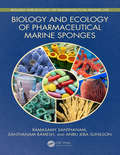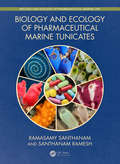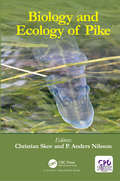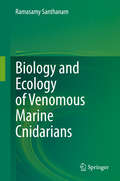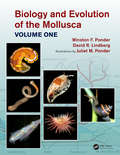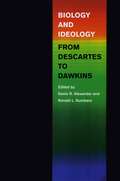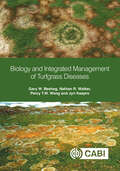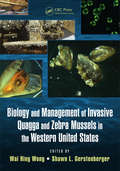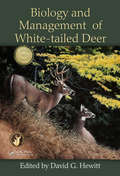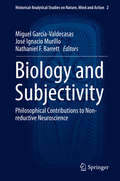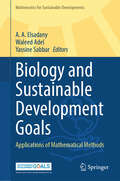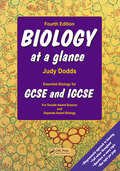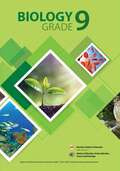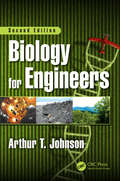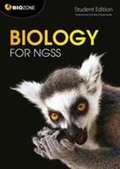- Table View
- List View
Biology and Ecology of Pharmaceutical Marine Sponges (Biology and Ecology of Marine Life)
by Ramasamy Santhanam Santhanam Ramesh Anbu SunilsonKey features: Serves as a standard reference for researchers, teachers and students of various disciplines such as Fisheries Science, Marine Biology, Life Sciences, Biotechnology, Natural Products, and Pharmacy, their libraries, and as a valuable guide for pharmaceutical companies involved in the development of new drugs from marine sponges Presents the taxonomy, common name, global distribution, and habitat of 250 species of marine sponges Provides the diagnostic features and pharmaceutical compounds (along with their chemical structure and activities) of 450 species of marine sponges Includes more than 500 detailed illustrations Biology and Ecology of Pharmaceutical Marine Sponges is the first comprehensive book of its kind written by scientists from both the Marine Biology and Pharmacy disciplines to fill the long-felt need for a marine natural products book devoted exclusively to sponges. Sponges are the most primitive multicelled animals that have existed for 700 - 800 million years. Despite their wide range of functional roles, not much is known about them. Marine sponges are responsible for more than 5,300 pharmaceutical products and some species have the potential to provide future drugs to prevent and treat important medical conditions such as cancer, a range of viral diseases, malaria, and inflammatory diseases. Nucleosides derived from sponges were the basis for the synthesis of Ara-C, the first marine-derived anticancer agent, currently used in the routine treatment of patients with leukemia and lymphoma. Marine sponges are the potential sources of many unique metabolites with anticancer,anti-inflammatory, antibiotic, antiviral, antimalarial, and immune or neurosuppressive properties. Although many bioactives have been discovered in marine sponges, only a few of these compounds have been commercialized. This book hopes to change that, providing the taxonomy, common name, global distribution, habitat, diagnostic features and pharmaceutical compounds (along with their chemical structure and activities) of 450 species of marine sponges, accompanied by high-quality illustrations. The book should be a standard reference for students, researchers and teachers of disciplines such as Fisheries Science, Marine Biology, Biochemistry, Biotechnology and Pharmacy and a valuable guide for pharmaceutical companies involved in the development of new drugs from marine sponges.
Biology and Ecology of Pharmaceutical Marine Tunicates (Biology and Ecology of Marine Life)
by Ramasamy Santhanam Santhanam RameshThe ocean is a source of unique natural products, mainly accumulated in living organisms. The c.4000 species of tunicates or sea squirts (Phylum, Chordata; Subphylum, Urochordata) are a high-potential yet under-studied source of bioactive compounds for pharmaceuticals. The secondary metabolites such as alkaloids isolated from these organisms have led to the discovery of an approved anti-tumor drug, anti-cancer drugs Yondelis® and Aplidin®, as well as many others in clinical trial. There is an urgent need for more research on the bioactive compounds of marine tunicates and better knowledge about the identification and biology of these species. This is the first focused book to meet this need. The taxonomy, common name, global distribution, habitat, diagnostic features and pharmaceutical compounds (along with their activities) of 165 key species of tunicates are given, with high-quality illustrations. Contributed by scientists of both Marine Biology and Pharmacy disciplines, this book will serve as a standard reference for researchers, teachers and students of Fisheries Science, Marine Biology, Life Sciences, Biotechnology, Natural Products, and Pharmacy, and as a valuable guide for pharmaceutical companies involved in the development of new drugs from marine organisms.
Biology and Ecology of Pike
by Christian Skov P. Anders NilssonThis book sets out to bridge the order scales among pike researchers, populations, communities, management, and fisheries. It emphasizes the progress of pike research during the last two decades, during which the order-bridging approach emerged. This framework underpins the text and the message, to convey its importance to pike research and to fish research in general. In addition, a considerable part of the book is devoted to management implications and highlights aspects of human dimensions in recreational fisheries.
Biology and Ecology of Venomous Marine Cnidarians
by Ramasamy SanthanamSeas and oceans cover 71 % of the earth’s surface and they are home to 80% of all life found on the planet . Among the different components of marine life, the phylum Cnidaria (formerly Coelenterata) has been reported to be responsible for more envenomations than any other marine phylum. It is believed that 2% of its known 11000 species are venomous to humans. Incidents caused by jellyfish are common all around the globe, with serious manifestations and occasional deaths reported in some countries. The Australian box jellyfish, Chironex fleckeri , has been reported to be very dangerous to humans, as contact with its tentacles can provoke immediate cardiovascular collapse and death within minutes. Though other volumes on venomous marine fauna are available, this is the first comprehensive book focusing on venomous marine cnidarians. It is a valuable text-cum-reference resource for researchers, teachers and students of various disciplines, including fisheries science, marine biotechnology and marine biology and for university and college libraries. It is also a useful guide for beachgoers, divers, physicians and environmentalists.
Biology and Evolution of the Mollusca, Volume 1
by Winston Frank Ponder David R. Lindberg Juliet Mary PonderMolluscs comprise the second largest phylum of animals (after arthropods), occurring in virtually all habitats. Some are commercially important, a few are pests and some carry diseases, while many non-marine molluscs are threatened by human impacts which have resulted in more extinctions than all tetrapod vertebrates combined. This book and its companion volume provide the first comprehensive account of the Mollusca in decades. Illustrated with hundreds of colour figures, it reviews molluscan biology, genomics, anatomy, physiology, fossil history, phylogeny and classification. This volume includes general chapters drawn from extensive and diverse literature on the anatomy and physiology of their structure, movement, reproduction, feeding, digestion, excretion, respiration, nervous system and sense organs. Other chapters review the natural history (including ecology) of molluscs, their interactions with humans, and assess research on the group. Key features of both volumes: up to date treatment with an extensive bibliography; thoroughly examines the current understanding of molluscan anatomy, physiology and development; reviews fossil history and phylogenetics; overviews ecology and economic values; and summarises research activity and suggests future directions for investigation. Winston F Ponder was a Principal Research Scientist at The Australian Museum in Sydney where he is currently a Research Fellow. He has published extensively over the last 55 years on the systematics, evolution, biology and conservation of marine and freshwater molluscs, as well as supervised post graduate students and run university courses. David R. Lindberg is former Chair of the Department of Integrative Biology, Director of the Museum of Paleontology, and Chair of the Berkeley Natural History Museums, all at the University of California. He has conducted research on the evolutionary history of marine organisms and their habitats on the rocky shores of the Pacific Rim for more than 40 years. The numerous elegant and interpretive illustrations were produced by Juliet Ponder.
Biology and Evolution of the Mollusca, Volume 2
by Winston Frank Ponder David R. Lindberg Juliet Mary PonderThis volume provides individual treatments of the major molluscan taxa. Each chapter provides an overview of the evolution, phylogeny and classification of a group of molluscs, as well as more specific and detailed coverage of their biology (reproduction, feeding and digestion, excretion, respiration etc.), their long fossil record and aspects of their natural history. The book is illustrated with hundreds of colour figures. In both volumes, concepts are summarised in colour-coded illustrations. Key selling features: Comprehensively reviews molluscan biology and evolutionary history Includes a description the anatomy and physiology of anatomical systems Up to date treatment with a comprehensive bibliography Reviews the phylogenetic history of the major molluscan lineages
Biology and Ideology from Descartes to Dawkins
by Ronald L. Numbers Denis R. AlexanderUntil well into the twentieth century neither scientists themselves nor the scholars who studied science linked science with ideology, a term coined in the late eighteenth century and typically employed pejoratively to designate ideas in the use of particular interests. Among the first to connect ideology and science were Karl Marx and his followers, who identified "ideologies" as ideas that served the social interests of the bourgeoisie.
Biology and Integrated Management of Turfgrass Diseases
by Dr Gary W. Beehag Dr Nathan R. Walker Dr Percy T.W. Wong Dr Jyri KaaproCultivated turfgrass is an assemblage of mown, perennial grasses or prostrate-growing forb plants and a suite of microbes all competing with each other in a common environment. This book approaches turfgrass diseases from an ecological perspective and explains with examples how wild plants and microbes have co-evolved. It addresses the identification, biology and integrated management of both common turfgrass diseases and newly emergent diseases. It includes the common and lesser-known turfgrass species, their surrounding environment and the range of beneficial and pathogenic microbes which in combination explain why disease occurs. For disease identification purposes, fungal diseases are arranged according to their predominantly cool season and warm season occurrence. Turfgrass bacterial and viral diseases, and plant parasitic nematodes are also covered. Written by a team of international authors, it combines technical expertise and practical experience. Essential for anyone involved in managing turfgrass, this book provides the know-how to identify the early warning signs of diseases, in order to manipulate the environment and minimise the damage.
Biology and Management of Invasive Quagga and Zebra Mussels in the Western United States
by Wai Hing Wong Shawn L. GerstenbergerBiology and Management of Invasive Quagga and Zebra Mussels in the Western United States is a synthesis of the biology and management of invasive mussels from scientists and managers working on invasive quagga and zebra mussels in the western United States. Invasive dreissenid mussels have spread throughout southwestern United States at unprecedent
Biology and Management of White-tailed Deer
by David G. HewittWinner of the Wildlife Society Outstanding Edited Book Award for 2013!Winner of the Texas Chapter of The Wildlife Society Outstanding Book Award for 2011!Winner of a CHOICE Outstanding Academic Title Award for 2011!Biology and Management of White-tailed Deer organizes and presents information on the most studied large mammal species in the world. The book covers the evolutionary history of the species, its anatomy, physiology, and nutrition, population dynamics, and ecology across its vast range (from central Canada through northern South America). The book then discusses the history of management of white-tailed deer, beginning with early Native Americans and progressing through management by Europeans and examining population lows in the early 1900s, restocking efforts through the mid 1900s, and recent, overabundant populations that are becoming difficult to manage in many areas. Features: Co-published with the Quality Deer Management Association Compiles valuable information for white-tailed deer enthusiasts, managers, and biologists Written by an authoritative author team from diverse backgrounds Integrates white-tailed deer biology and management into a single volume Provides a thorough treatment of white-tailed deer antler biology Includes downloadable resources with color images The backbone of many state wildlife management agencies' policies and a featured hunting species through much of their range, white-tailed deer are an important species ecologically, socially, and scientifically in most areas of North America. Highly adaptable and now living in close proximity to humans in many areas, white-tailed deer are both the face of nature and the source of conflict with motorists, home-owners, and agricultural producers. Capturing the diverse aspects of white-tailed deer research, Biology and Management of White-tailed Deer is a reflection of the resources invested in the study of the species’ effects on ecosystems, predator-prey dynamics, population regulation, foraging behavior, and browser physiology.
Biology and Management of the Formosan Subterranean Termite and Related Species
by Nathan Lo Qian Sun Thomas Chouvenc J. Kenneth Grace Claudia Husseneder Shuji Itakura Hou-Feng Li Kok-Boon Neoh Wakako Ohmura Faith M. Oi Rudolf H. Scheffrahn Gaku Tokuda Edward L. Vargo Chia-Chien Wu Koichi YamamotoThe Formosan subterranean termite, Coptotermes formosanus, is the most destructive and invasive termite species globally. It is also the only termite species listed in the world's 100 worst invasive alien species of the Global Invasive Species Database. Annually, its infestation costs more than $4 billion in control and damage repairs in the USA alone. This book is the first comprehensive resource drawing on all the literature on C. formosanus since Tokuichi Shiraki first described the species in 1909. The book covers the worldwide distribution of this species, its biogeography, and how it has dispersed from its native range in southern China and Taiwan to different parts of the world. It describes its present taxonomic status and discusses the species' biology, ecology, foraging behavior, physiology, chemical ecology and its association with symbionts. From a practical standpoint, the authors address all of the various management options for this species, such as baits, soil termiticides, wood preservatives, inspection and detection technologies, and Integrated Pest Management (IPM) approaches. Lastly, there are chapters dedicated to another important destructive species, Coptotermes gestroi (the Asian subterranean termite), and the recently discovered C. formosanus/C. gestroi hybrids. This important book is an essential and valuable reference for researchers, graduate students, pest management professionals, chemical manufacturer personnel, building and property managers, and others. It provides readers with a comprehensive understanding of the biology and management of the Formosan subterranean termite and the Asian subterranean termite.
Biology and Management of the World Tarpon and Bonefish Fisheries
by Jerald S. AultThe core of a multibillion dollar sport fishing industry, tarpon and bonefish, two of the earth's oldest creatures, are experiencing obvious and precipitous population decline. Experienced anglers in the Florida Keys suggest a drop of approximately 90-95 percent for the bonefish population over the last 65 years. Despite the economic value of the i
Biology and Pathology of the Oocyte
by Roger Gosden Alan Trounson Roger Gosden Ursula Eichenlaub-Ritter Alan TrounsonThe human oocyte, or egg, is the rarest and most rapidly aging cell in the body, and is essential for fertility. This book is about the development and pathology of the oocyte, and includes information on new technologies to manipulate, enhance, and control fertility. Leading world experts contribute essays on the basic and applied science of the egg, its clinical manipulation, and its pivotal role in reproductive medicine and biology.
Biology and Subjectivity: Philosophical Contributions to Non-reductive Neuroscience (Historical-Analytical Studies on Nature, Mind and Action #2)
by Miguel García-Valdecasas José Ignacio Murillo Nathaniel F. BarrettSome may consider that the language and concepts of philosophy will eventually be superseded by those of neuroscience. This book questions such a naïve assumption and through a variety of perspectives and traditions, the authors show the possible contributions of philosophy to non-reductive forms of neuroscientific research. Drawing from the full range and depth of philosophical thought, from hylomorphism to ethics, by way of dynamical systems, enactivism and value theory, amongst other topics, this edited work promotes a rich form of interdisciplinary exchange. Chapters explore the analytic, phenomenological and pragmatic traditions of philosophy, and most share a common basis in the Aristotelian tradition. Contributions address one or more aspects of subjectivity in relation to science, such as the meaning and scope of naturalism and the place of consciousness in nature, or the relation between intentionality, teleology, and causality. Readers may further explore the nature of life and its relation to mind and then the role of value in mind and nature. This book shows how philosophy might contribute to real explanatory progress in science while remaining faithful to the full complexity of the phenomena of life and mind. It will be of interest to both philosophers and neuroscientists, as well as those engaged in interdisciplinary cooperation between philosophy and science.
Biology and Sustainable Development Goals: Applications of Mathematical Methods (Mathematics for Sustainable Developments)
by A. A. Elsadany Waleed Adel Yassine SabbarThis edited book provides a comprehensive framework for the integration of mathematical methodologies into biological research, emphasizing applications that directly address topics related to SDG 3 (Good Health and Well Being) and SDG 6 (Clean Water and Sanitation). From the mathematical modeling of infectious diseases to the design of smart agricultural systems, each chapter presents key global issues where mathematical analysis is a powerful tool for driving progress. This work emphasizes the importance of mathematical models in predicting outcomes, optimizing interventions and understanding the dynamics of complex biological systems. The central theme of the book is the application of mathematical methods, ranging from deterministic models, stochastic processes, fractional calculus and machine learning algorithms to biological problems, framed in the context of sustainability. Each chapter is crafted to showcase how mathematical models not only enhance our understanding of biological phenomena but also play a pivotal role in developing solutions to global issues such as pandemics, environmental degradation and resource management.
Biology at a Glance
by Judy DoddsThe fourth edition of a bestseller, this book presents, in a clear, concise, and visual way, the main biological content required by all the examining boards for both the GCSE Double Award Science and separate Biology Award, including IGCSE. It is also useful as an introductory guide for AS Biology. The fourth edition has been revised to include new material on industrial fermenters and their applications, plus additional material on flowering plants.
Biology class 10 - SCERT - Kerala Board: ജീവശാസ്ത്രം മലയാളം മീഡിയം ക്ലാസ് 10 എസ്.ഇ.ആര്.ടി കേരള ബോര്ഡ്
by Kerala ScertBiology Malayalam Medium Class 10 SCERT Kerala Board 1 is divided into four parts. The lessons cover sense organs, brain and nervous systems, hormones and their actions and finally the diseases and reasons. The topics are presented with detailed illustraions and images and tables.
Biology class 11 - NCERT - 23
by National Council of Educational Research and TrainingThe NCERT Biology textbook for Class 11 provides a comprehensive introduction to the vast and intricate world of living organisms. It begins with an exploration of what defines life and delves into the rich diversity and classification of living beings. The textbook introduces the concept of taxonomy and the tools associated with it in "The Living World" chapter. Following this, it presents a detailed five-kingdom classification system in the "Biological Classification" chapter, discussing entities that challenge traditional classification, such as viruses, viroids, and lichens. In the "Plant Kingdom" chapter, students are acquainted with the diverse groups of plants and their unique characteristics. Throughout, the text emphasizes the interconnectedness of life and the importance of understanding the natural world's complexities. This foundational knowledge sets the stage for more advanced biological studies in subsequent grades.
Biology class 12 - Meghalaya Board
by Meghalaya Board of School EducationThe class 12 Biology textbook deals with the physiological process of reproduction in flowering plants and humans, the principles of inheritance, the nature of genetic material and its function, the contributions of biology to human welfare, basic principles of biotechnological processes and their applications and achievements.
Biology class 12 - NCERT
by National Council of Educational Research and TrainingThe Class XII Biology textbook deals with the physiological process of reproduction in flowering plants and humans, the principles of inheritance, the nature of genetic material and its function, the contributions of biology to human welfare, basic principles of biotechnological processes and their applications and achievements.
Biology class 9 - MIE
by Mauritius Institute of EducationThe Grade 9 Biology textbook from the Mauritius Institute of Education covers four comprehensive units. The first unit delves into the intricacies of the human Blood Circulatory System, exploring the structure and functions of blood, the heart, and blood vessels. It addresses topics like blood cell types, pulse, and cardiovascular diseases. The Reproduction unit explores both asexual and sexual reproduction in living organisms, detailing the structures and functions of human male and female reproductive systems, fertilization, embryo development, and the significance of reproductive health. The Biodiversity unit introduces the concept's importance for survival, explaining how to estimate species using quadrats and addressing factors affecting biodiversity. The final unit, Nutrition in Plants, delves into photosynthesis, emphasizing factors like light, carbon dioxide, water, and chlorophyll, and includes practical demonstrations on starch presence in leaves.
Biology for Christian Schools, with Laboratory Exercises, Volume A (3rd Edition)
by Brad R. Batdorf Thomas E. PorchDesigned to be used as a Personal Interactive Learning Resource, this book is divided into three units. The Science of Life deals with topics basic to all biological studies. The Science of Organisms is a survey of the major groups of living things on our planet. This unit takes the traditional classificatory approach to studying organisms. The Study of Human Life includes sections on human anatomy and physiology and on Christian philosophy related to our physical, mental, and spiritual selves.
Biology for Christian Schools, with Laboratory Exercises, Volume B (3rd Edition)
by Brad R. Batdorf Thomas E. PorchThe book is divided into two sections, viz. Book A and Book B. Book A deals with The Study of Life in fourteen chapters. Book B has 11 chapters and each deal with The Invertebrates Zoology, The Arthropods Zoology, The Ectothermic Vertebrates Zoology, The Endothermic Vertebrates Zoology, Ecology, Introduction to Human Anatomy and Physiology, Incoming Substances, Internal Transport, The Nervous System Control, Hormones and the Human Mind Control and Human Reproduction.
Biology for Engineers, Second Edition
by Arthur T. JohnsonBiology is a critical application area for engineering analysis and design, and students in engineering programs as well as ecologists and environmentalists must be well-versed in the fundamentals of biology as they relate to their field. Biology for Engineers, Second Edition is an introductory text that minimizes unnecessary memorization of connections and classifications and instead emphasizes concepts, technology, and the utilization of living things. Whether students are headed toward a bio-related engineering degree or one of the more traditional majors, biology is so important that all engineering students should know how living things work and act. Emphasizing the ever-present interactions between a biological unit and its physical, chemical, and biological environments, the book provides ample instruction on the basics of physics, chemistry, mathematics, and engineering through a systems approach. It brings together all the concepts one needs to understand the role of biology in modern technology.Classroom-tested at the University of Maryland, this comprehensive text introduces concepts and terminology needed to understand more advanced biology literature. Filled with practical detailed examples, the book presents: Presents scientific principles relevant to biology that all engineers, ecologists and environmentalists must know A discussion of biological responses from the perspective of a broad range of fields such as psychology, human factors, genetics, plant and animal physiology, imaging, control systems, actuary, and medicine Includes end of chapter questions to test comprehension Provides updated material to reflect the latest research developments such as CRISPR Introduces over 150 interesting application examples, incorporating a number of different engineering disciplines Ties biological systems properties and behaviors to foundational sciences such as engineering sciences, chemistry, etc
Biology for NGSS (Student Edition, Second Edition)
by Tracey Greenwood Richard Allan Kent Pryor Lissa Bainbridge-SmithBiology for NGSS has been specifically written to meet the requirements of the Next Generation Science Standards (NGSS) for High School Life Sciences (HS-LS). It is a hybrid resource that's part textbook, part study guide and part activity book all rolled into one.
